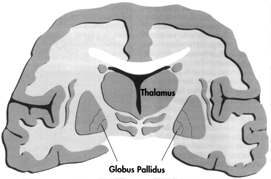#13
|
|
#15
|
p400
Cerebellum The term Cerebellum means Little Brain. It communicates with other regions of the CNS through Three Large Nerve Tracts: the Superior, Middle, and Inferior Cerebellar Peduncles. The Cerebellum is organized like the Cerebrum, with Gray Matter both on the inside as Nuclei and on the outside as Cortex. The Cerebellar Cortex has Gyri and Sulci, but the Gyri are much smaller than those of the Cerebrum. The Cerebellum consists of Three Portions: the FlocculoNodular Lobe. A narrow Central Vermis, and Two large Lateral Hemispheres. The FlocculoNodular Lobe is the simplest portion of the Cerebellum and is involved in Balance. The Anterior Portion of the Vermis is involved in Gross Motor Coordination, and the Posterior Vermis and Lateral Hemispheres are involved in Fine Motor Coordination - producing smooth, flowing movements. A major function of the Cerebellum is that of a Comparator. Impulses from the Motor Cortex descend into the Spinal Cord to initiate Voluntary Movements, and at the same time impulses are sent from the Motor Cortex to the Cerebellum, giving the Cerebellar Neurons information representing the Intended Movement. Simultaneously, Impulses from the Proprioceptive Neurons (providing information about the Position of the body or body parts) that innervate the joints and tendons of the structure being moved, reach the Cerebellar Cortex (Proprioception). These impulses give the Cerebellar Neurons information from the Periphery about the Actual Movements. The Cerebellum Compares Impulses from the Motor Cortex with those from the Moving Structures (it compares the intended movement with the actual movement). And if a difference is detected, the Cerebellum sends Impulses to the Motor Cortex and the Spinal Cord to correct the discrepancy. The result is smooth and coordinated movements. With training a person can develop highly skilled and rapid movements that are accomplished more rapidly than can be accounted for by the Comparator Function of the Cerebellum. In these cases the Cerebellum can "learn" highly specialized Motor Functions through specific, repeated comparator activities. Continued In scan-02a.html |
